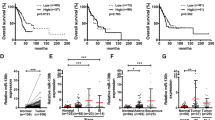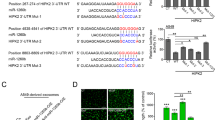Abstract
Membrane-type 1 matrix metalloproteinase (MT1-MMP/MMP-14) has been believed a key enzyme in tumor invasion, because it is expressed in a variety of malignant human tumors, and overexpression of the enzyme enhances the ability of cellular invasiveness. However, it has not necessarily been clarified whether the endogenously expressed MT1-MMP in human tumors plays a critical role in their invasiveness. We used RNA silencing technology to downregulate the endogenous MT1-MMP expression in human tumor cells (fibrosarcoma HT1080 and gastric carcinoma MKN-28 cell lines), and evaluated the effect on the invasion of a reconstituted basement membrane (Matrigel). Transfection of a double-stranded RNA targeted to the MT1-MMP gene decreased the level of the enzyme to less than 10–20% without affecting production of other MMPs. According to the degree of silencing, activation of proMMP-2 was inhibited. CD44 shedding was also inhibited, but only in part. Decreased MT1-MMP levels were also reflected in reduced cell motility on hyaluronan (HA) and invasion in Matrigel. Thus, specific downregulation of MT1-MMP expression was sufficient to cause significant inhibition of the migration and invasion of tumor cells, even though other MMPs continued to be expressed.
This is a preview of subscription content, access via your institution
Access options
Subscribe to this journal
Receive 50 print issues and online access
$259.00 per year
only $5.18 per issue
Buy this article
- Purchase on Springer Link
- Instant access to full article PDF
Prices may be subject to local taxes which are calculated during checkout






Similar content being viewed by others
Abbreviations
- MMP:
-
matrix metalloproteinase
- MT-MMP:
-
membrane-type matrix metalloproteinase
- TIMP:
-
tissue inhibitor of metalloproteinase
References
Atkinson SJ, Crabbe T, Cowell S, Ward RV, Butler MJ, Sato H, Seiki M, Reynolds JJ and Murphy G . (1995). J. Biol. Chem., 270, 30479–30485.
Belkin AM, Akimov SS, Zaritskaya LS, Ratnikov BI, Deryugina EI and Strongin AY . (2001). J. Biol. Chem., 276, 18415–18422.
Dong Z, Kumar R, Yang X and Fidler IJ . (1997). Cell, 88, 801–810.
Egeblad M and Werb Z . (2002). Nat. Rev. Cancer, 2, 161–174.
Elbashir SM, Harborth J, Lendeckel W, Yalcin A, Weber K and Tuschl T . (2001). Nature, 411, 494–498.
Goebeler M, Kaufmann D, Brocker EB and Klein CE . (1996). J. Cell Sci., 109, 1957–1964.
Gunthert U, Hofmann M, Rudy W, Reber S, Zoller M, Haussmann I, Matzku S, Wenzel A, Ponta H and Herrlich P . (1991). Cell, 65, 13–24.
Hotary K, Allen E, Punturieri A, Yana I and Weiss SJ . (2000). J. Cell Biol., 149, 1309–1323.
Itoh Y, Takamura A, Ito N, Maru Y, Sato H, Suenaga N, Aoki T and Seiki M . (2001). EMBO J., 20, 4782–4793.
Kajita M, Itoh Y, Chiba T, Mori H, Okada A, Kinoh H and Seiki M . (2001). J. Cell Biol., 153, 893–904.
Koshikawa N, Giannelli G, Cirulli V, Miyazaki K and Quaranta V . (2000). J. Cell Biol., 148, 615–624.
McCawley LJ and Matrisian LM . (2001a). Curr. Opin. Cell Biol., 13, 534–540.
McCawley LJ and Matrisian LM . (2001b). Curr. Biol., 11, R25–7.
Mori H, Tomari T, Koshikawa N, Kajita M, Itoh Y, Sato H, Tojo H, Yana I and Seiki M . (2002). EMBO J., 21, 3949–3959.
Nagase H and Woessner Jr JF . (1999). J. Biol. Chem., 274, 21491–21494.
Naot D, Sionov RV and Ish-Shalom D . (1997). Adv. Cancer Res., 71, 241–319.
Nomura H, Sato H, Seiki M, Mai M and Okada Y . (1995). Cancer Res., 55, 3263–3266.
Okada Y . (2000). Verh. Dtsch. Ges. Pathol., 84, 33–42.
Okamoto I, Kawano Y, Matsumoto M, Suga M, Kaibuchi K, Ando M and Saya H . (1999a). J. Biol. Chem., 274, 25525–25534.
Okamoto I, Kawano Y, Tsuiki H, Sasaki J, Nakao M, Matsumoto M, Suga M, Ando M, Nakajima M and Saya H . (1999b). Oncogene, 18, 1435–1446.
Okamoto I, Tsuiki H, Kenyon LC, Godwin AK, Emlet DR, Holgado-Madruga M, Lanham IS, Joynes CJ, Vo KT, Guha A, Matsumoto M, Ushio Y, Saya H and Wong AJ . (2002). Am. J. Pathol., 160, 441–447.
Overall CM and Lopez-Otin C . (2002). Nat. Rev. Cancer, 2, 657–672.
Overall CM, McQuibban GA and Clark-Lewis I . (2002). Biol. Chem., 383, 1059–1066.
Pei D and Weiss SJ . (1996). J. Biol. Chem., 271, 9135–9140.
Ratnikov BI, Rozanov DV, Postnova TI, Baciu PG, Zhang H, DiScipio RG, Chestukhina GG, Smith JW, Deryugina EI and Strongin AY . (2002). J. Biol. Chem., 277, 7377–7385.
Sato H, Takino T, Okada Y, Cao J, Shinagawa A, Yamamoto E and Seiki M . (1994). Nature, 370, 61–65.
Sato T, del Carmen Ovejero M, Hou P, Heegaard AM, Kumegawa M, Foged NT and Delaisse JM . (1997). J. Cell Sci., 110, 589–596.
Seiki M . (1999). Apmis, 107, 137–143.
Seiki M . (2002). Curr. Opin. Cell Biol., 14, 624–632.
Sneath RJ and Mangham DC . (1998). Mol. Pathol., 51, 191–200.
Stetler-Stevenson WG and Yu AE . (2001). Semin. Cancer Biol., 11, 143–152.
Tsunezuka Y, Kinoh H, Takino T, Watanabe Y, Okada Y, Shinagawa A, Sato H and Seiki M . (1996). Cancer Res., 56, 5678–5683.
Webb DJ, Parsons JT and Horwitz AF . (2002). Nat. Cell Biol., 4, E97–E100.
Yana I and Weiss SJ . (2000). Mol. Biol. Cell, 11, 2387–2401.
Zhou Z, Apte SS, Soininen R, Cao R, Baaklini GY, Rauser RW, Wang J, Cao Y and Tryggvason K . (2000). Proc. Natl. Acad. Sci. USA, 97, 4052–4057.
Zucker S, Cao J and Chen WT . (2000). Oncogene, 19, 6642–6650.
Acknowledgements
We thank Drs Ikuo Yana, Naohiko Koshikawa, Hidetoshi Mori, Takamasa Uekita, Hirokazu Matsuki, Hiroyuki Nakamura, and Yoshifumi Itoh for valuable discussion. This work was supported by the Special Coordination Fund for promoting Science and Technology from the Ministry of Science and Technology of Japan and by a grant-in-aid for Cancer Research from the Ministry of Education, Science and Culture of Japan.
Author information
Authors and Affiliations
Corresponding author
Rights and permissions
About this article
Cite this article
Ueda, J., Kajita, M., Suenaga, N. et al. Sequence-specific silencing of MT1-MMP expression suppresses tumor cell migration and invasion: importance of MT1-MMP as a therapeutic target for invasive tumors. Oncogene 22, 8716–8722 (2003). https://doi.org/10.1038/sj.onc.1206962
Published:
Issue Date:
DOI: https://doi.org/10.1038/sj.onc.1206962
Keywords
This article is cited by
-
The proprotein convertase furin in cancer: more than an oncogene
Oncogene (2022)
-
A cell surface display fluorescent biosensor for measuring MMP14 activity in real-time
Scientific Reports (2018)
-
Synthesis and study of new 5-substituted 1-acetyl-4-phenyl-3-pyrrolin-2-ones as potential antitumor agents
Chemistry of Heterocyclic Compounds (2018)
-
Establishment and characterization of a new feline mammary cancer cell line, FkMTp
Cytotechnology (2016)
-
Soluble CD44 concentration in the serum and peritoneal fluid samples of patients with different stages of endometriosis
Archives of Gynecology and Obstetrics (2015)



